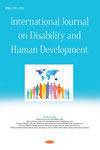Adaptation: Vineland Adaptive Behavior Scale for 3–9 year-old Indian children
International Journal on Disability and Human Development
Pub Date : 2016-02-01
DOI:10.1515/ijdhd-2014-0026
引用次数: 5
Abstract
Abstract Aim: This study aimed to translate the Vineland Adaptive Behavior Scale (VABS) II Survey Form into Hindi and then adapt and use it in evaluating 3–9 year-old Indian children. Methods: The VABS II was translated to Hindi and its reliability and validity were checked. Then, it was used in a sample of 3–9 year-old children. Adaptive behavior composite (ABC) Scores, domain standard scores (DSS) and maladaptive-v scores (MBI) were compared. Results: Out of 433 items, 44 (10.16%) needed adaptation but no satisfactory adaptation could be made for 16 (3.6%). The adapted instrument was proven reliable and valid. Significant differences were found in all domains (except MBI) with higher scores for urban vs. rural children, school-goer vs. non-school-goer, working vs. housewife mothers and higher socioeconomic status (SES), but not between children of joint and nuclear families. Motor development significantly correlated with weight-for-age percentage, which in turn, correlated to the variables studied. Conclusions: The VABS was satisfactorily translated and adapted for Indian children. In addition, it was found that socioeconomic status significantly affected the social development.适应:3-9岁印度儿童Vineland适应行为量表
摘要目的:本研究旨在将Vineland适应行为量表(VABS) II调查问卷翻译成印地语并应用于3-9岁印度儿童的评估。方法:将VABS II翻译成印地语,并对其信度和效度进行检验。然后,它被用于3-9岁儿童的样本。比较自适应行为综合评分(ABC)、领域标准评分(DSS)和适应不良v评分(MBI)。结果:433个项目中有44个(10.16%)需要适应,16个(3.6%)不满意适应。经验证,该仪器是可靠有效的。在所有领域(MBI除外),城市儿童与农村儿童、上学儿童与非上学儿童、工作母亲与家庭主妇以及更高的社会经济地位(SES)得分较高,但在联合家庭和核心家庭的儿童之间没有显著差异。运动发育与体重年龄比例显著相关,而年龄比例又与所研究的变量相关。结论:VABS对印度儿童的翻译和改编令人满意。此外,社会经济地位对社会发展有显著影响。
本文章由计算机程序翻译,如有差异,请以英文原文为准。
求助全文
约1分钟内获得全文
求助全文

 求助内容:
求助内容: 应助结果提醒方式:
应助结果提醒方式:


